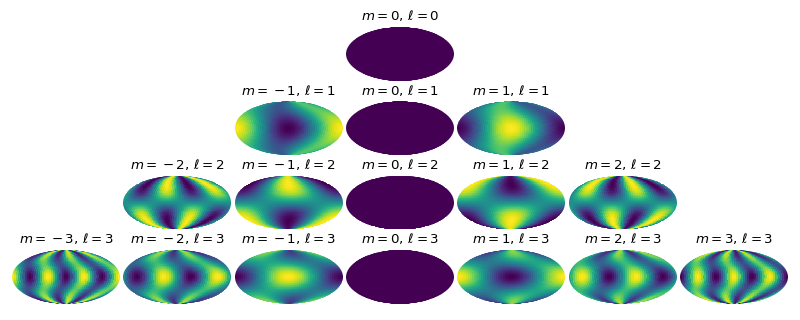Background¶
Perturbed spherical harmonic basis: temperature map¶
The photospheric temperature of an exoplanet, as a function of the planetary latitude \(\theta\) and longitude \(\phi\) can be defined as:
such that \(T_\mathrm{eq} = f T_\mathrm{eff} \sqrt{R_\star/a}\) is the equilibrium temperature for greenhouse factor \(f\), stellar effective temperature \(T_\mathrm{eff}\), and normalized semimajor axis \(a/R_\star\); \(A_B\) is the Bond albedo. The prefactor on the left acts as a constant scaling term for the absolute temperature field, on which the \(h_{ml}\) terms are a perturbation.
The \(h_{m\ell}(\alpha, \omega_\mathrm{drag})\) terms are defined by:
where
is the dimensionless fluid number of Heng & Workman (2014), and is a function of the Reynold’s number \(\mathcal{R}\) and the Prandtl number \(\mathcal{P}\). \(\omega_\mathrm{drag}\) is the dimensionless drag frequency, \(\mu = \cos\theta\), \(\tilde{\mu}=\alpha \mu\), \(H_\ell(\tilde{\mu})\) are the Hermite polynomials:
Phase curve¶
We can then compute the thermal flux emitted by the planet at any orbital phase \(\xi\), which is normalized from zero at secondary eclipse and \(\pm\pi\) at transit:
given the blackbody function defined as:
where \(T(\theta, \phi)\) is the temperature map described with the perturbed spherical harmonic basis functions in the previous section, and \(\mathcal{F_\lambda}\) is the filter throughput.
The observation that we seek to fit is the infrared phase curve of the exoplanet, typically normalized as a ratio of the thermal flux of the planet normalized by the thermal flux of the star, like so:
where the intensity \(I\) is given by
for a filter bandpass transmittance function \(\mathcal{F}_\lambda\).
Example temperature fields¶
The first several terms in the spherical harmonic expansion of the temperature map in the \(h_{m\ell}\) basis. Each subplot shows the temperature perturbation (purple to yellow is cold to hot) as a function of latitude and longitude (shown in Mollweide projections such that the substellar longitude is in the center of the plot). The \(m = 0\) terms are always zero. The \(\ell=2\) terms are asymmetric about the equator and therefore do not represent typical GCM results, so we keep all \(\ell=2\) terms fixed to zero in the subsequent fits. These maps were generated with \(\alpha=0.6\) and \(\omega_\mathrm{drag} = 4.5\).
(Source code, png, hires.png, pdf)

Below is the same as above, but this time for \(\alpha=0.9\) and \(\omega_\mathrm{drag} = 1.5\) – note that when the drag is set to a smaller value, the chevron shape becomes more pronounced as a perturbation on the temperature maps with \(\ell \neq 0\).
(Source code, png, hires.png, pdf)
